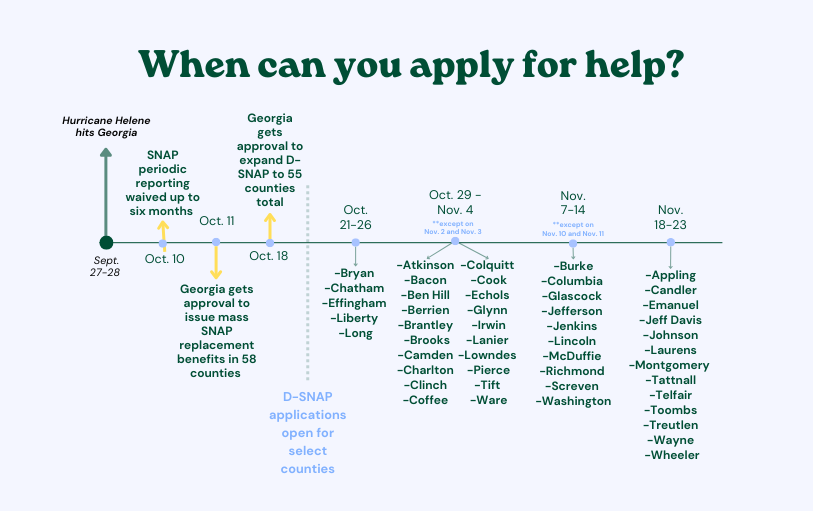
Section Branding
Header Content
What to know about food assistance following damage from recent hurricanes
Primary Content
People in communities damaged by recent hurricanes have an opportunity to get extra food assistance through adjustments made to the Supplemental Nutrition Assistance Program and other temporary federal programs. But there are some hard deadlines to apply for help.
First, SNAP recipients who lost food due to power outages in designated storm-affected counties have until Friday, Oct. 25 to file food loss replacement forms. Those forms should be submitted either online or in person at local DFCS offices.
According to records from the Department of Human Services, over 70,000 food loss replacement forms have been submitted since Sept. 28.
Separately, the approval of another federal waiver means some extra assistance is guaranteed. Regardless of whether or not SNAP recipients submit the form above, those in 58 designated counties will see up to 75% of their monthly benefits replaced, no action required.
That means an infusion of cash for SNAP-eligible items, which in Georgia has temporarily changed to include hot foods, though only through Nov. 23.
For people who do not receive SNAP benefits, a similar program is now in effect.
Last week, the U.S. Department of Agriculture approved Georgia’s request to issue D-SNAP, or the Disaster Supplemental Nutrition Assistance Program, in 55 total counties.
“This one-time benefit is intended for people who do not currently receive SNAP but who are in a low-to-moderate income household and sustained damage or loss of income as a result of the disaster,” wrote Department of Human Services spokesperson Ellen Brown.
D-SNAP benefits cover the purchase of the same foods as SNAP does, but benefits are being distributed on a tighter timeline.
For one, people can only register for D-SNAP during phases designated to their county. There are four phases — the first started Oct. 21 for counties in Coastal Georgia. Each phase includes pre-registration on Georgia Gateway for an interview to come later either over the phone or in-person.

Brown said for the interview, people should call on the date assigned by the program to the first initial of their last name. That list of dates can be found online and will be updated.
Cindy Long, Deputy Under Secretary for the food, nutrition and consumer services at the USDA, said people should apply for D-SNAP even if they haven't been eligible for regular SNAP benefits previously.
“We will take into account a range of circumstances specifically associated with the disaster,” Long said. “Don't assume you're not eligible if you feel like you need it.”
D-SNAP benefits will vary but Long said a family of four could receive around $975. That’s a one-time benefit for the month.
“The intent is for those benefits to get out as quickly as possible,” Long said.
She estimates tens of thousands of people will take advantage of D-SNAP in areas affected by recent storms.
Food loss is a top concern among people visiting Disaster Recovery Centers around Georgia, according to Deanna Swain with the Federal Emergency Management Agency.
At a center in Lyons in central Georgia, Swain said over 600 people have come in seeking assistance since the doors opened late last week.
She said while agents working at the centers cannot directly help with SNAP, they can make referrals. At the center in Lyons, located inside a Department of Human Services building, that means pointing people to a desk across the room.
“We always try to connect people with as many sources to help them get back on their feet as possible, and that includes referencing them to local and state programs, as well as volunteer organizations that are in the communities,” Swain said.


